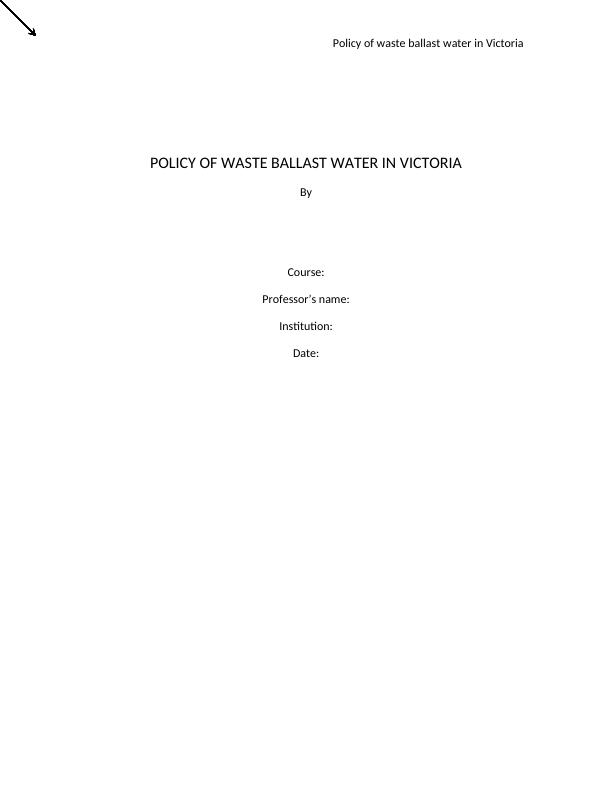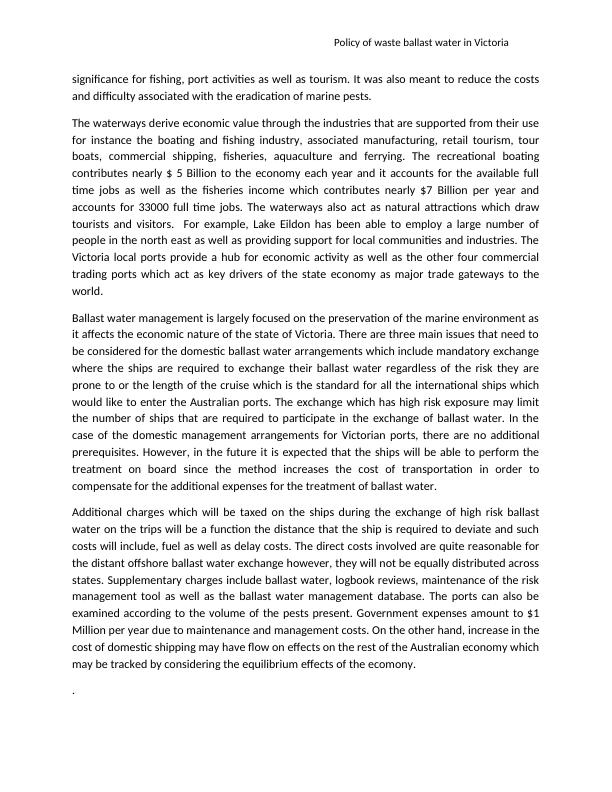Policy of waste ballast water in Victoria
7 Pages2661 Words145 Views
Added on 2019-11-25
Policy of waste ballast water in Victoria
Added on 2019-11-25
ShareRelated Documents
Policy of waste ballast water in Victoria POLICY OF WASTE BALLAST WATER IN VICTORIAByCourse:Professor’s name:Institution:Date:

Policy of waste ballast water in Victoria POLICY OF WASTE BALLAST WATER IN VICTORIAINTRODUCTIONMost of the parts of Victoria, there are a number of water channels, which include bay, rivers,inlets, lakes and the coast. Victoria has roughly 2500 km of coastline, and there are more than120 bays, inlets and estuaries along its dimensions. Victoria's three largest bays are WesternPort, Corner Inlet and Port Phillip. The state also has more than 85,000 km of rivers and 13,000natural wetlands. Victoria's channels support a broad range of industries and activities such ascommercial operations like commercial fishing, aquaculture, boat repair, marine, commercialshipping, and related industries, cruise ships, tourism and transport (ferries) operators (Goss1990, pp. 221-223). And also recreational prospects are provided including boating, fishing,swimming, diving and water sports. Other services provided from Victoria water channels arethe emergency and regulatory services, agriculture production through irrigation, domesticwater usage by urban and rural, as cultural pride and heritage sites, as home to many flora andfauna, including scarce and endangered species, wetlands of national and internationalenvironmental importance. Ballast water is used to ensure that the structural integrity of vessels and their stability wasmaintained. It's typically pumped out when the cargo is loaded onto the ship and pumped inwhen the ship is offloaded. Ballast water is essential to ship for efficient transportation but alsoendangers aquatic species through relocating them to the environment that they have notadopted thus threatening their life; this poses a serious ecological, economic and health threatto the local communities. This water may also contain harmful substances and disease causingorganism. Victorians decided to impose a policy that would deal with ballast water on ships andvessels. In 1991, a ship released 100000m2 water ballast at the coast of Peru in whichcontained viruses and bacteria which was responsible for the outbreak of cholera in Peru; thiskilled over 10000 people in the area (Karjalainen 2017). This research shows how severe theeffects of water of ballast can be to human life. BALLAST WATER POLICY OF VICTORIA The marine pests introduced in the waterways through the expulsion of ballast water whichthreatened the biodiversity and the economic benefits derived from the marine environment, itwas necessary to introduce a policy that facilitated ballast water management. The main aim ofthe plan was to protect the beneficial uses of the state waters through the minimizing of risksof introducing marine pests in the waters, fulfil commonwealth requirements concerninginternational ballast water through the establishment of risk based management in Victoria forthe domestic ballast water. Also, the aim of the policy was to protect and maintain economic

Policy of waste ballast water in Victoria significance for fishing, port activities as well as tourism. It was also meant to reduce the costsand difficulty associated with the eradication of marine pests.The waterways derive economic value through the industries that are supported from their usefor instance the boating and fishing industry, associated manufacturing, retail tourism, tourboats, commercial shipping, fisheries, aquaculture and ferrying. The recreational boatingcontributes nearly $ 5 Billion to the economy each year and it accounts for the available fulltime jobs as well as the fisheries income which contributes nearly $7 Billion per year andaccounts for 33000 full time jobs. The waterways also act as natural attractions which drawtourists and visitors. For example, Lake Eildon has been able to employ a large number ofpeople in the north east as well as providing support for local communities and industries. TheVictoria local ports provide a hub for economic activity as well as the other four commercialtrading ports which act as key drivers of the state economy as major trade gateways to theworld.Ballast water management is largely focused on the preservation of the marine environment asit affects the economic nature of the state of Victoria. There are three main issues that need tobe considered for the domestic ballast water arrangements which include mandatory exchangewhere the ships are required to exchange their ballast water regardless of the risk they areprone to or the length of the cruise which is the standard for all the international ships whichwould like to enter the Australian ports. The exchange which has high risk exposure may limitthe number of ships that are required to participate in the exchange of ballast water. In thecase of the domestic management arrangements for Victorian ports, there are no additionalprerequisites. However, in the future it is expected that the ships will be able to perform thetreatment on board since the method increases the cost of transportation in order tocompensate for the additional expenses for the treatment of ballast water.Additional charges which will be taxed on the ships during the exchange of high risk ballastwater on the trips will be a function the distance that the ship is required to deviate and suchcosts will include, fuel as well as delay costs. The direct costs involved are quite reasonable forthe distant offshore ballast water exchange however, they will not be equally distributed acrossstates. Supplementary charges include ballast water, logbook reviews, maintenance of the riskmanagement tool as well as the ballast water management database. The ports can also beexamined according to the volume of the pests present. Government expenses amount to $1Million per year due to maintenance and management costs. On the other hand, increase in thecost of domestic shipping may have flow on effects on the rest of the Australian economy whichmay be tracked by considering the equilibrium effects of the ecomony..

End of preview
Want to access all the pages? Upload your documents or become a member.
